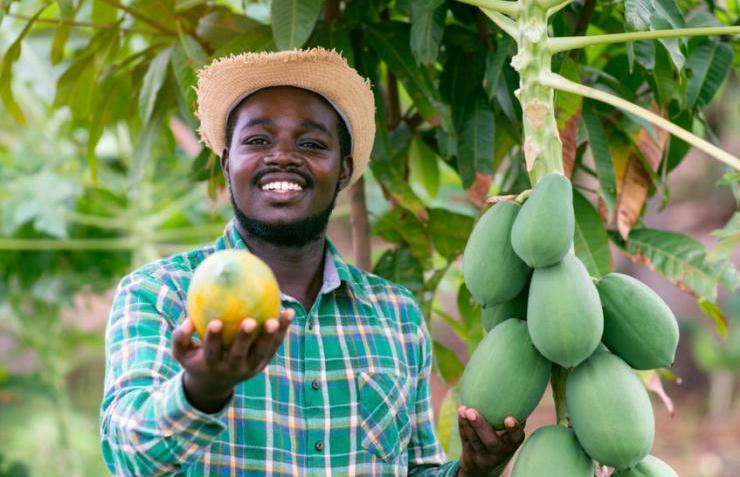“The Key Is Agroecology”.

The director of the Institute for Research and Promotion of Alternatives in Development, Mamadou Goita, criticizes the policies of the African Development Bank.
And he argues that it is necessary to transition to a model based on access to the land, the rational use of natural resources and the re-appropriation of the genetic heritage is necessary.
In Africa, traditional methods of agricultural production, which aimed at food self-sufficiency, have been destabilized by the model of the green revolution. Before its imposition, soil fertility was safeguarded, and plant and animal biodiversity were promoted. The model of the green revolution, already developed in India, arrived on the African continent in the 1970s. Productivity at any cost with the combination of three factors: intensive use of synthetic fertilizers, adoption of hybrid seeds, and intensive water management. The model was supposed to ensure food security. Added to this is the entry of multinationals which has completely changed African food systems.

Mamadou Goita, director of IRPAD (Institute for Research and Promotion of Alternatives in Development). File: AFSAfrica
The new model focused on products with high-added value that could be marketed abroad. The Ivory Coast has intensified the production of cocoa and coffee, Mali, and Burkina Faso that of cotton, and peanuts in Senegal. These industrial crops prevailed at the expense of the more nutritious cereal crops. The catastrophe came in the early 1980s when governments were forced to adopt structural adjustment plans after years of indebtedness. The state, at that point, withdrew completely from the sector by abandoning the farmers. In Mali, for example, there was an industrial fabric linked to agriculture: the processing of juice, mills for grinding cereals and manufacturing units for agricultural work tools. Industries have been privatized, cereal production has dropped due to the invasion of products for the international market, and everything has shifted to cotton. We talked about it with Mamadou Goita, a member of the panel of experts of the IPES-Food international study centre, executive director of IRPAD (Institute for Research and Promotion of Alternatives in Development) and one of the founders of AFSA (Alliance for Food Sovereignty in Africa).
Why does the green revolution model not work?
Because it completely eroded the genetic diversity of our peasant seeds which were able to withstand drought. Furthermore, industrial hybrid seeds could not be replicated but had to be repurchased every year. Now it is the landed assets that are in danger. With the excuse that the farmers are no longer productive, the lands were handed over to companies that produce monocultures for export. The model then generated deforestation, water pollution and changed the diet of Africans. We have become dependent on imports. Take rice for example: in West Africa, it was a niche product and is now the staple of the diet.

The headquarters of the African Development Bank in Abidjan, Ivory Coast. CC BY 3.0/ Citizen59
The rice is imported from Asia and is of poor quality. It has taken the place of more nutritious crops such as millet and sorghum. Today Senegal is completely dependent on rice imports because it has lost the knowledge and skills to produce anything else, and even the traditional rice varieties best suited to survive in certain climates have disappeared.
Why do governments and institutions such as the African Development Bank (AFDB) still propose this model?
The AFDB is a problem for the continent. I know well how it works because I chair the Civil Society Coalition (CSO) for the transparency of this institution. The current president, Akinwumi Adesina, served as the vice president of AGRA (Alliance for a Green Revolution in Africa) and before that, he was in charge of the hybrid rice program Africa Rice. During his tenure as agriculture minister in Nigeria, he increased the use of chemical fertilizers. Most of the vice presidents present at the Dakar 2 summit last January come from the system of the World Bank, the International Monetary Fund, and the green revolution. Many heads of state and government are manipulated by this model and therefore benefit from the support of institutions such as the AFDB.
Last January, during the Dakar 2 summit (“Feeding Africa”), 34 African heads of state and government stressed the need to achieve food sovereignty. It is the same concept that you have been
claiming for years…
Now that African and global civil society is increasingly affirming the concepts of food sovereignty and agroecology, governments are trying to take them over. In Senegal, for example, there is a ministry of agriculture and food sovereignty, but the country is preparing to authorize the use of GMOs.

Food must be consumed first of all in the territories where it is grown, and the wealth generated within the communities must be reinvested. © Benedicte Kurzen/NOOR for FAO
At the Dakar 2 summit they did not invite any representatives of civil society who have been fighting for food sovereignty for years.
They try to appropriate the words, they promise funds and they sow discord within the peasant organizations, always conveying
the model of the green revolution.
What model of a food system do you propose?
Agroecology integrates production, transformation, conservation, and the sale of products. Food must be consumed first of all in the territories where it is grown, and the wealth generated within the communities must be reinvested.

A young local farmer standing on a grass with a bunch of garlic in his hands. The recognition of peasant seeds. 123rf
This means restoring soil quality, adopting a model of climate equity and justice, and focusing on diversity. Agroecology must be included in a model of food sovereignty that passes through the re-appropriation of our genetic heritage, based on access to land, the rational use of water and all natural resources. A fundamental role is played by the nearby markets where local agricultural products are found. An important step is the recognition of peasant seeds in all legislation so that they can be reproduced, exchanged, donated, or sold.
How can we change the mentalities of governments and supranational institutions?
Some regional integration institutions such as the Economic Community of West African States (CEDEAO), for example, have recognized food sovereignty. It is civil society; it is the farmers’ organizations that must continue to fight for the adoption of this model. In several countries, the movements are defining the strategy for agroecological transition. In eastern and central Africa, organizations have sprung up which ask for the recognition of peasant seeds. In Kenya, the movements that fight against GMOs have reached the Supreme Court. Initiatives to support agroecology have also sprung up in Tanzania, Uganda, and Cameroon. The situation in the north and south of the continent is more complicated. In South Africa, Morocco and Egypt, the green revolution model is deeply rooted and therefore more difficult to question. (Open Photo: 123rf)
Marta Gatti



